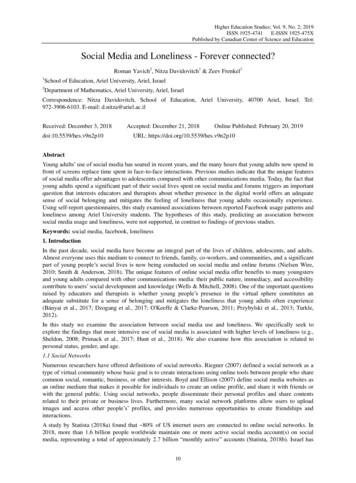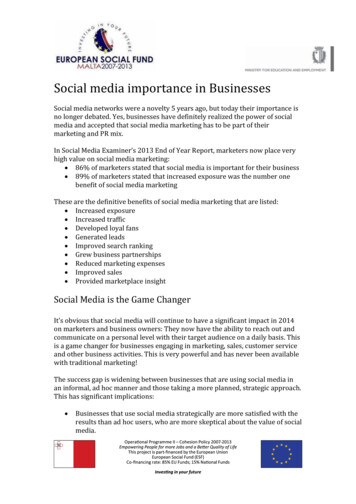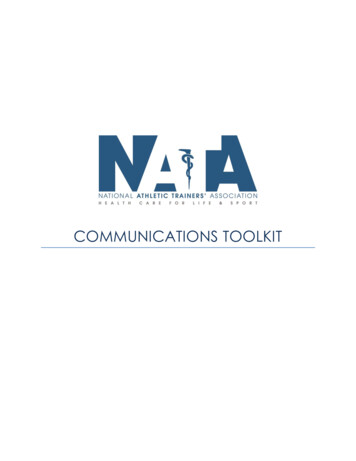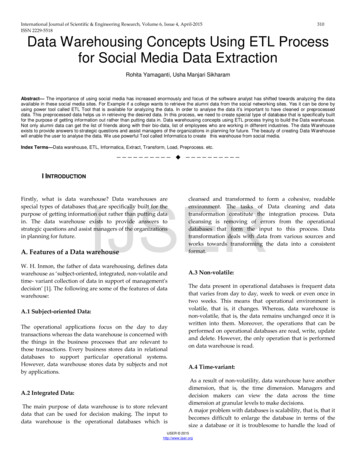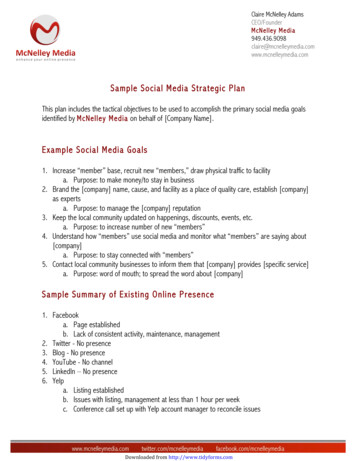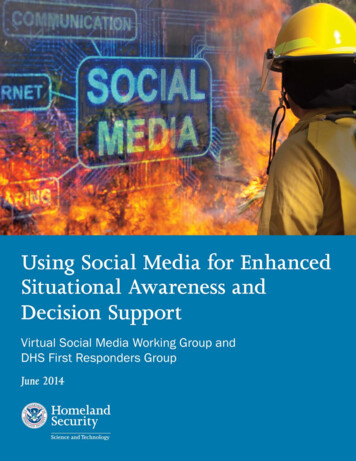
Transcription
1
TABLE OF CONTENTSEXECUTIVE SUMMARY . 4INTRODUCTION . 5PURPOSE . 6DEFINITIONS . 7TECHNOLOGY AND SITUATIONAL AWARENESS .8SOCIAL MEDIA AND SITUATIONAL AWARENESS .9APPLICATIONS OF SOCIAL MEDIA IN PUBLIC SAFETY.11Effective Communications .11Stakeholder Identification, Engagement, and Effective Messaging .11Rumor Management .12Achieving and Maintaining Situational Awareness .13Monitoring .13Crowdsourcing .14Intelligence Gathering .17Needs Identification and Planning .19Analysis.19Establishment of Baseline (Normalization) and Event Detection .20Trend Analysis .21Enhanced Decision Support .21CHALLENGES.24Technology .25Third-Party Platforms .25Geo-Location .27Technology Requirements .28Spatial-Temporal Lapses, Changes, and Re-Sharing .29Information .29Information Sharing .29Access to Information .30Volume and Velocity .31Aggregation and Filtering .31Veracity and Variety .312
Data and Information Integration .33Disparate and Virtual Communities .34Gaming .35Policy (Privacy, Legal, and Security-Related) Challenges .35AREAS OF FUTURE RESEARCH .38CONCLUSION .40REFERENCES .413
EXECUTIVE SUMMARYHigh-impact and high-visibility events have revealed the proliferation and widespread use of mobiledevices. Combined with the rise in popularity of social media, the subsequent explosion in availableinformation now spans multiple platforms and formats. Historically, the emergency response communityhas leveraged multiple data sources, including land mobile radios, maps, computer-aided dispatch, crisismanagement systems, traffic cameras, geographic information systems, and windshield assessments tocollect information. Now, responders can leverage social media as well, both to communicate and togather and share real-time, dynamic information to enhance situational awareness and assist in decisionmaking. The volume and speed with which available information is disseminated, combined with aninability to identify, verify, coordinate, aggregate, and contextualize it, however, can leave thisinformation unused and ultimately, un-actionable.This report discusses examples of how agencies currently leverage social media to enhance situationalawareness and support operational decision-making, as well as challenges and potential applications. Italso identifies critical areas requiring further consideration and research to address key technology,process, and policy gaps, including: Information Application: The ability to access, share, search, verify, contextualize, and manageavailable information. This concept also includes the identification of essential elements ofinformation in social media as they relate to traditional public safety information requirements.Privacy, Legal, and Security Challenges: There are several challenges associated with the use ofsocial media for situational awareness, especially with regards to user privacy and the use ofpersonally identifiable information (PII); the need to remove details when sharing informationacross multiple partners; and the security of networks, platforms, tools, and data.Data and Open Standards: To truly enhance situational awareness, social media must beintegrated, both technically and contextually, within the larger information environment and intothe public safety operational workflow. Additional considerations include event detection, dataformats, data models, ontologies, semantic and linked data, automation, and artificial intelligence.Technology Development: Challenges associated with the use of third-party platforms, analyticstools, the development of operational requirements, the ability to geo-locate informationpublished to social media, spatial-temporal characteristics (disparate and virtual communities,time decay of posts, etc.), and integration with NextGen911 will require further research.4
INTRODUCTIONSocial media and collaborative technologies are critical components of emergency preparedness,response, and recovery. From the international response efforts after major tsunamis to hurricanerecovery in major U.S. cities, government officials now turn to social media technologies to shareinformation and connect with citizens during all phases of a crisis. The adoption of new tools, however,requires consideration for application, implementation, and integration within traditional systems and methods.Recognizing the need to address these challenges, the U.S. Department of Homeland Security’s (DHS)Science and Technology Directorate (S&T) established the Virtual Social Media Working Group (VSMWG).The VSMWG seeks to provide guidance to the emergency preparedness and response community on thesafe and sustainable use of social media technologies before, during, and after emergencies.Comprised of a cross-section of subject matter experts from local, tribal, state, territorial, and federalresponders from across the United States, the VSMWG establishes and collects best practices andsolutions that can be leveraged by public safety officials and responders throughout the nation’semergency response community. VSMWG members belong to the agencies listed below.VSMWG Member Agencies as of April 2014 American Red CrossAnaheim [Calif.] Emergency Managementand PreparednessCenters for Disease Control and Prevention,Office of Public Health Preparedness andResponseCity of Charlottesville [Va.] Fire DepartmentClark [Wash.] Regional Emergency ServicesAgencyFederal Emergency Management AgencyThe George Washington UniversityHampton Roads [Va.] Planning DistrictCommissionHumanity Road 5Johnson County [Kan.] Sheriff’s OfficeMaryland Emergency Management AgencyCity of New Orleans Office of HomelandSecurity and Emergency PreparednessNew York City Office of EmergencyManagementOregon Voluntary Organizations Active inDisasterSan Francisco Department of EmergencyManagementUnited States Geological SurveyUnited States Northern CommandUniversity of Washington, Office of GlobalAffairs
PURPOSEThis report follows the VSMWG’s May 2013 publication, Lessons Learned: Social Media and HurricaneSandy, which identifies and analyzes gaps associated with social media technologies, processes, andpolicies that were identified during the Hurricane Sandy response in the fall of 2012. These include: Difficulty discovering available information, resources, and efforts across social media platformsand by multiple stakeholdersDifficulty sharing information across multiple platforms and stakeholders due to the lack ofstandardization in nomenclatures, and the need to develop a framework to do soDifficulty using social media for purposes other than communications and general information dueto an inability to contextualize and integrate social media data within the incident commandstructureAn inability to aggregate, search, vet, and validate social media dataConcerns with existing social media platform features, as well as reliability of service, access toinformation, simultaneous publication of information, and an inability to match needs toresources availableThe purpose of this document is to: Introduce and discuss how social media can and is currently being used for situational awarenessin public safety by various agencies and organizationsDiscuss challenges associated with the use of social media for situational awarenessDiscuss the integration of social media within the operational environmentDiscuss areas requiring further consideration, research, and developmentExamples included in this document are not intended to serve as an all-inclusive list. For more informationand additional resources, please visit the DHS First Responder Communities of Practice website.6
DEFINITIONSThe terminology used to describe various aspects of Web-related technologies varies in definition,depending on perspective, domain, and discipline. The following apply to key terms used within thisdocument.Big Data: “Big data” refers to “high-volume, high-velocity, and high-variety information assets thatdemand cost-effective, innovative forms of information processing for enhanced insight and decisionmaking.” 1Crowd-Feeding: Crowd-feeding is the active, two-way feedback loop where information or tasksconducted by the crowd are fed or shared back to the crowd. 2Crowd-Harvesting: Crowd-harvesting is the passive, one-way gathering of data to search for informationfrom the crowd information. 3Crowd-Seeding: Crowd-seeding is the strategic, one-way request that pre-identifies certain members in acrowd to source from and empower them with tools. 4Crowd-Sourcing: Crowd-sourcing is the active, one-way request between the crowd and entity requestinginformation from the crowd (the crowd-sourcer). 5Intelligence: Intelligence is “the combination of credible information with quality analysis – informationthat has been evaluated and from which conclusions have been drawn.” 6Metadata: Metadata is data that describes other data. In context with social media, metadata refers tothe various attributes available in addition to the text of social media updates (e.g., geo-location, posttime, follower count).Semantic Web: The semantic Web is considered “an extension of the current web in which information isgiven well-defined meaning, better enabling computers, and people to work in cooperation.” 71“Big Data.” Information Technology (IT) Glossary. Gartner.com. 27 January 2014. http://www.gartner.com/itglossary/big-data/ .2Liu, Sophia B. (2014). “Crisis Crowdsourcing Framework: Designing Strategic Configurations of Crowdsourcing forthe Emergency Management Domain.” Computer-Supported Cooperative Work special issue on Crisis Informatics andCollaboration.3Liu IBID4Liu IBID5Liu IBID6Carter, David L. (2004). Chapter Two; “Understanding Contemporary Law Enforcement Intelligence: Concept andDefinition.” Law Enforcement Intelligence: A Guide for State, Local, and Tribal Law Enforcement Agencies. November2004. School of Criminal Justice, Michigan State /law/LawEnforcementIntelligenceGuide.pdf .7“The Semantic Web Made Easy.” World Wide Web Consortium (W3C). May 2001. http://www.w3.org/RDF/Metalog/docs/sw-easy .7
Situational Awareness: Situational awareness refers to a state of understanding in which the followingoccur: 8 Knowing and understanding what is happening around youPredicting how it will change with timeBeing unified with the dynamics of your environment (i.e., contextualization with the currentenvironment given specific factors, variables, goals, and objectives)Situational awareness is a “human mental process that can be enhanced using technology to access,analyze, and present information to have a greater understanding of existing conditions and how they willchange over time.” 9The Homeland Security Act of 2002 defines the term “situational awareness” as “information gatheredfrom a variety of sources that, when communicated to emergency managers and decision makers, canform the basis for incident management decision-making.” 10Social Media: Social media is defined as any online or digital medium that is provided or collected througha channel that enables the two-way sharing of information, involving multiple parties. This includes socialnetworking sites, texting, and blogs.TECHNOLOGY AND SITUATIONAL AWARENESSSituational awareness is not a new concept in the field of emergency preparedness, response, andrecovery. In fact, it is one of the focus points within most planning and response efforts. Governmentagencies and response partners work to establish and maintain situational awareness to sustain generalcommunications, gather intelligence from the field, execute logistical plans, track resources, send alertsand warnings, and perform general operations. Traditional methods for achieving and maintainingsituational awareness include land mobile radio, paper maps, landlines, email, cellular phones, satellitephones, mobile data (e.g., low-speed wireless data), computer-aided dispatch for incident and unit status,crisis management systems (e.g., E-Team, WebEOC), traffic cameras, amateur (HAM) radios, enhanced911, reverse 911, mobile text alerts, global positioning services (GPS) for the location of response vehicles,geographic information systems (GIS) for visualization, windshield assessments, and traditional media(e.g., television, radio).The following graphic, 11 published in ESRI’s 2008 report, Public Safety and Homeland Security SituationalAwareness, 12 illustrates the various traditional data sources available to produce and maintain situationalawareness. Sources include maps, media, transportation, infrastructure, communications tools, sensors,8ESRI. “Public Safety and Homeland Security Situational Awareness.” ESRI. February 2008: 1. tional-awareness.pdf .9ESRI. “Public Safety and Homeland Security Situational Awareness.” ESRI. February 2008: 2. tional-awareness.pdf .10thUnited States Congress. “Homeland Security Act of 2002.” 107 Congress. Section 515 (6 U.S.C. 321d(b)(1)) 25November 2002. http://www.dhs.gov/xlibrary/assets/hr 5005 enr.pdf .11ESRI, IBID, Page 3, Icons by Zee Que, Designbolts.com12ESRI, IBID, Page 1.8
bio-data, environmental data, base map data, applets such as location tracking, science information suchas emergency response guides, and interfaces such as telemetry. Various social media tools have beenadded to the graphic to illustrate their role in the situational awareness taxonomy.GIS Situational Awareness TaxonomySOCIAL MEDIA AND SITUATIONAL AWARENESSCombined with the expansion and convergence of broadband and wireless, the advent and rise inpopularity of social media now enables the public safety community to request, share, and provideinformation; real-time, content-rich, profile updates; video; and photo imagery through additionalchannels. For these sources to become useful, however, various data management, analytics, andoperational standards and processes must be developed.If integrated with traditional data, social media can help emergency responders achieve and maintainsituational awareness in real-time. This will assist with decision-making, planning, and resource allocation.9
This report discusses the challenges associated with the integration of social media data within theinformation sharing and operational environment, as well as the potential applications, best practices, andconsiderations for better leveraging social media to enhance situational awareness and decision support,including: Standardization of technology capabilities and tool features across various platformsDefinition and identification of useful information via social media sourcesAbility to aggregate, sort, filter, verify, and manage information pulled from social mediaAbility to integrate information learned from social media sources within the operationalenvironment in a meaningful wayUse of social media data to predict and model potential outcomes and cascading effectsA need for interoperability of social media data, including data standards and content categoriesto support information sharing among multiple stakeholdersA wide variety of tools is now available to aggregate and analyze social media for the purpose ofmaintaining situational awareness. Ranging from simple to complex, decision makers must balance thebenefit of new technology and capabilities with budgetary and resource realities.13 Agencies may hesitateto leverage tools that are not provided by another government entity (such as those developed orprovided by the private sector or a non-profit organization). Additionally, the variety and availability oftools and technologies may overwhelm decision makers, especially given a lack of guidance on theacquisition, integration, and implementation of new tools with legacy systems.The role an agency plays in a disaster, in addition to the type of disaster, may determine the type ofinformation needed and available, and ultimately the tool needed or developed. For example, in additionto information about the status of roads, power lines, and the safety of individuals in the aftermath of ahurricane, a public health agency may focus on the community’s understanding of water boil notices, thesafety of the drinking water, outbreaks resulting from possible contamination, or disease. 14 Additionalfactors affecting perspective, goals, and objectives for information learned from social media include thetype of scenario (man-made versus natural, quick versus slow onset), pre-existing informationrequirements, mission objectives, functionality (operations versus external affairs and communications),and constituent demographics.Examples of free and open-source search analytical and mapping toolsinclude MapQuest, Geofeedia, Google Earth, TweetDeck, Social Mention, and HootSuite. Tools offeringanalytical algorithms, prediction and outcome modeling, and proprietary analytical decision supportinclude Calais, Zemanta, General Dynamics’ TIGR (Tactical Ground Reporting System), U.S. NorthernCommand’s (USNORTHCOM) SAGE (Situational Awareness Geospatial Enterprise), Palantir,the Department of Energy’s RaptorX, and IBM InfoSphere. The American Red Cross uses the Radian6platform developed by Salesforce.com to pull social media content from several platforms, includingTwitter, Facebook, and blogs. The tool then aggregates and analyzes the data and displays information13Homeland Security Systems Engineering and Development Institute. First Responder Big Data Analytics: RoadmapRecommendations. 5 February 2014.14Hanrion, Natalie. Information provided March 2014.10
that is selected to be of interest to the user. 15APPLICATIONS OF SOCIAL MEDIA IN PUBLIC SAFETYWhile traditional methods for establishing and maintaining situational awareness remain intact, new andinnovative methods for identifying, aggregating, visualizing, contextualizing, and operationalizinginformation are now possible as the popularity of new tools and platforms grows. The following sectiondiscusses various applications for information gleaned from social media sources. Social media is no longersolely for communications; many areas of disaster preparedness, mitigation, response, and recovery maybenefit from the addition of social media as well. Examples included in this section do not serve as anexhaustive list.Effective CommunicationsStakeholder Identification, Engagement, and Effective Messaging16One of the first examples of the use of social media for public safety purposes is the AMBER Alertprogram, a voluntary partnership between law enforcement agencies, broadcasters, transportationagencies, and the wireless industry. The AMBER Alert system is activated to send an urgent bulletin in themost serious child abduction cases. Since 2003, AMBER Alerts have interrupted regular programming andare broadcast on the radio, television, and highway signs. The alerts can be printed on lottery tickets, andsent electronically to wireless devices and the Internet. In 2007, Myspace users received notifications ontheir home page for alerts issued within their registered ZIP code. Facebook followed suit in January 2011,partnering with the Department of Justice and the National Center for Missing and Exploited Children(NCMEC) to issue alerts based on users’ states or regions. 17Today, public safety can use social media to engage stakeholders strategically, empowered by theplatforms’ search and targeting capabilities. Additionally, social media channels may serve as a feedbackmechanism, assisting communicators in identifying the receipt and success of messaging, necessarychanges in content or channel, outcomes of messaging (e.g., actions taken as a result of the messagesent), and new demographics requiring specific targeting or further consideration. Success includespenetration of messaging, or how deep into the community the message travels, and the level of “trust” inthe message. This includes noticeable or measurable actions taken by individuals if the message requestsan action or re-sharing of the message with personal networks.On July 9, 2013, Shayne Adamski, senior manager of digital engagement for the Federal EmergencyManagement Agency (FEMA), testified before the House Committee on Homeland Security’sSubcommittee on Emergency Preparedness, Response, and Communications. Adamski shared informationon how FEMA leverages social media in a variety of ways to “reach the public and provide them withuseful information.” According to Adamksi, FEMA uses social media in six primary ways:15DHS Virtual Social Media Working Group. “Lessons Learned: Hurricane Sandy and Social Media.” June 2013.DHS Virtual Social Media Working Group. “Community Engagement and Social Media Best Practices”. September2012.17Howard, Alex. “Facebook Teams up With DoJ, NCMEC to Issue Social AMBER Alerts.” Govfresh.com. 12 January2012. oj-ncmec-to-issue-social-amber-alerts/ .1611
To provide up-to-date information about how FEMA and the whole community emergencymanagement team are helping communities and individuals in mitigation, preparedness,response, and recovery from disasters (e.g., posting photos and status updates capturing FEMAactivities such as deployment of Disaster Survivor Assistance teams helping survivors)To help federal, state, local, tribal, territorial, and private sector partners share key messages (e.g.,sharing status updates from key public officials before, during, and after Hurricane Sandy)To provide safety and preparedness tipsTo inform the public of the most effective ways to help disaster survivors (e.g., encouragingAmericans to donate through trusted charities to help impacted communities)To tell disaster survivors where and how to receive assistance from FEMA and other sourcesTo gain valuable feedback (e.g., Twitter chats to engage the public on specific issues such as howto receive aid necessary for rebuilding after an event) 18Rumor Management 19Not all rumors are false or untrue; sometimes they are merely facts not yet verified by an official source.Individuals will often act upon information before it can be verified, in the absence of officialinformation. 20 Misinformation can spread via social media very quickly, especially during an emergency.Additionally, due to the viral nature of social media, misinformation may spread across multiple networks,locations, and disparate groups, leading to ineffective decision-making, hazardous actions, and inaccuratedirections. Although the spreading of rumors cannot be completely halted, public safety officials can oftencorrect misinformation through active, ongoing engagement with the public and response partners. Thisrequires both active listening for specific or applicable information as well as passive monitoring forgeneral situational awareness.Active: Public safety officials can actively “listen” to social media to engage the public and respond tospecific comments. Agencies can actively engage the community, specifically requesting information orasking for assistance to identify and correct misinformation.For example, throughout the course of the response to Hurricane Sandy in the fall of 2012, the AmericanRed Cross monitored social media to identify needs, provide information, and respond to questions andconcerns raised by the public. With assistance from digital volunteers, the Red Cross social engagementteam tracked and reviewed more than two million posts. Team members and volunteers identifiedactionable posts and actively sent responses to individuals posting questions about the disaster situation,how to obtain help, and how to offer assistance. They also shared Red Cross messaging, disseminatedofficial response operation information, and provided emotional support through conversations with18Adamski, Shayne, Senior Manager of Digital Engagement, Federal Emergency Management Agency. Statement tothe U.S. House of Representatives Committee on Homeland Security Subcommittee on Emergency Preparedness,Response, and Communications. Subcommittee Hearing: Emergency MGMT 2.0: How #SocialMedia & New Tech arethstTransforming Preparedness, Response, & Recovery #Disasters #Part2 #Govt/NGOs. 9 July 2013. 113 Congress, 1session. 1047/HHRG-113-HM12-Wstate-AdamskiS20130709.pdf .19DHS Virtual Social Media Working Group. “Lessons Learned: Social Media and Hurricane Sandy.” June 2013.20Shibutani, Tomatsu. Improvised News. Indianapolis: The Bobbs-Merrill Company, Inc., 1966.12
people affected by the disaster. 21Passive: Public safety officials can leverage social media to observe chatter regarding general informationabout their respective agency, mission space, or jurisdiction. Additionally, they can use social media toidentify and respond to rumors and misinformation before they are disseminated too widely. For example,throughout the response to Hurricane Sandy, FEMA searched for information, aggregated rumorsidentified on social networks, and published corrected information on chieving and Maintaining Situational AwarenessSocial media provides a means to search for and solicit information for general and specific inquiries,verify pre-existing information, and establish general situational awareness. Many open-source toolsfeature searches based on a keyword, geographic location, or content, including trending topic
Situational Awareness: Situational awareness refers to a state of understanding in which the following occur: 8 Knowing and understanding what is happening around you Predicting how it will change with time Being unified with the dynamics of y







